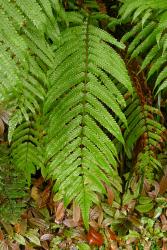Terrestrial (NZ) or rarely epiphytic (not NZ) ferns. Rhizomes short- to long-creeping, erect or forming a short arborescent trunk, scaly. Fronds monomorphic or rarely dimorphic, not articulated to rhizome. Laminae undivided (not NZ) or 1-pinnate to 3-pinnate-pinnatifid (NZ), catadromous, herbaceous or coriaceous, usually hairy, sometimes bearing glands, rarely also scaly, often with aerophores in two lines on stipe and rachis and on abaxial surfaces at bases of pinnae. Veins free (NZ), or with one or more basal veins from adjacent pinna lobes uniting below the sinus (NZ), or rarely reticulate (not NZ). Sori round or slightly elongate, superficial, borne on abaxial surface away from margins; paraphyses usually absent or rarely present; indusia reniform, irregularly shaped or absent; sporangial maturation mixed. Sporangia with vertical annulus, usually 64 spores per sporangium. Homosporous; spores monolete (NZ) or rarely trilete (not NZ), lacking chlorophyll; perispores reticulate, winged, echinate or tuberculate.
A family of 37 genera and almost 1200 species (Fawcett & Smith 2021; Fawcett et al. 2021).
Thelypteridaceae is one of the largest and most diverse families of ferns, and its taxonomy has been contentious, with many different classifications recognising anything from a single genus (Fraser-Jenkins et al. 2017) to 32 genera (Pichi Sermolli 1977). A detailed history of these classifications was provided by Fawcett & Smith (2021) and Fawcett et al. (2021). Their phylogenomic investigation of 621 samples encompassed all the known genera and about half the species in the family. They ultimately recognised 37 genera, including 14 that were re-circumscribed and seven that were newly described. Their classification is adopted here.
In New Zealand, Allan (1961) recognised only a single genus, Thelypteris, with five indigenous species. However, in a review of the family in the Pacific and Australasia, Holttum (1977), raised this to five genera – Christella, Cyclosorus, Macrothelypteris, Pneumatopteris and Thelypteris – a treatment that has been widely accepted until now. In stark contrast to the diversity in Australia (Bostock 1998), Fiji (Brownsey & Perrie 2011) and the south-west Pacific (Nakamura 2008), each of these genera is monotypic and easily distinguished in New Zealand. However, Fawcett et al. (2021) showed that Pneumatopteris was highly polyphyletic with species scattered in many different lineages. One of these was the New Zealand and south-east Australian species, P. pennigera, which was found to be distantly related to other taxa in the family, resolving on a long branch as sister to the rest of the christelloid clade. Fawcett & Smith referred it to a new, monotypic genus, Pakau, which is accepted here. In addition, a single species of the naturalised genus Pseudophegopteris is now known to occur in New Zealand (Ogle et al. 2021).
| 1 | Fertile laminae at least 2-pinnate-pinnatifid; lamina hairs up to 2 mm long; indusia 0.2–0.4 mm wide | Macrothelypteris |
| Fertile laminae 1-pinnate or 1-pinnate-pinnatifid, but not more divided; lamina hairs up to 1 mm long; indusia absent or, if present, 0.4–1.2 mm wide | 2 | |
| 2 | All veins free | 3 |
| At least the basal pair of veins in each pinna segment uniting with those from adjacent segments | 4 | |
| 3 | Basal basiscopic pinnules on proximal primary pinnae longer than adjacent pinnules; rachis and stipe red-brown; indusia absent | Pseudophegopteris |
| Basal basiscopic pinnules on proximal pinnae ± same length as adjacent pinnules; rachis and stipe pale brown or green; indusia present | Thelypteris | |
| 4 | Rhizomes erect; sori lacking indusia | Pakau |
| Rhizomes erect or creeping; sori with well-developed indusia | 5 | |
| 5 | Basal pair of pinnae much shorter than those at mid-lamina | Christella |
| Basal pair of pinnae about as long as those at mid-lamina | Cyclosorus |
The family Thelypteridaceae comprises mostly terrestrial ferns with undivided to 3-pinnate-pinnatifid fronds, which bear hairs and sometimes also glands and scales. Characteristically the veins are mostly free, except that the basal veins of the pinna lobes often unite below the sinus. The sori are usually round, away from the margin, and either exindusiate or protected by reniform indusia. The sporangia have a vertical annulus, and almost always produce monolete spores.
Widespread in tropical and sub-tropical regions, with a few species extending into temperate zones. The greatest diversity is found in Malesia, with 440 species (Holttum 1982), and the Neotropics, with another 300 species (Smith 1990). There are about 100 species in the Pacific region (Holttum 1977) and 23 in Australia (Bostock 1998). Five non-endemic and one naturalised genera with six species in New Zealand; none endemic.
| Category | Number |
|---|---|
| Indigenous (Non-endemic) | 5 |
| Exotic: Casual | 1 |
| Total | 6 |




